DJI FPV drone review: experience the thrills of first person view flight
Strap on your goggles and get ready for the flight of a lifetime with the DJI FPV; the world's first tech-filled FPV drone for beginners
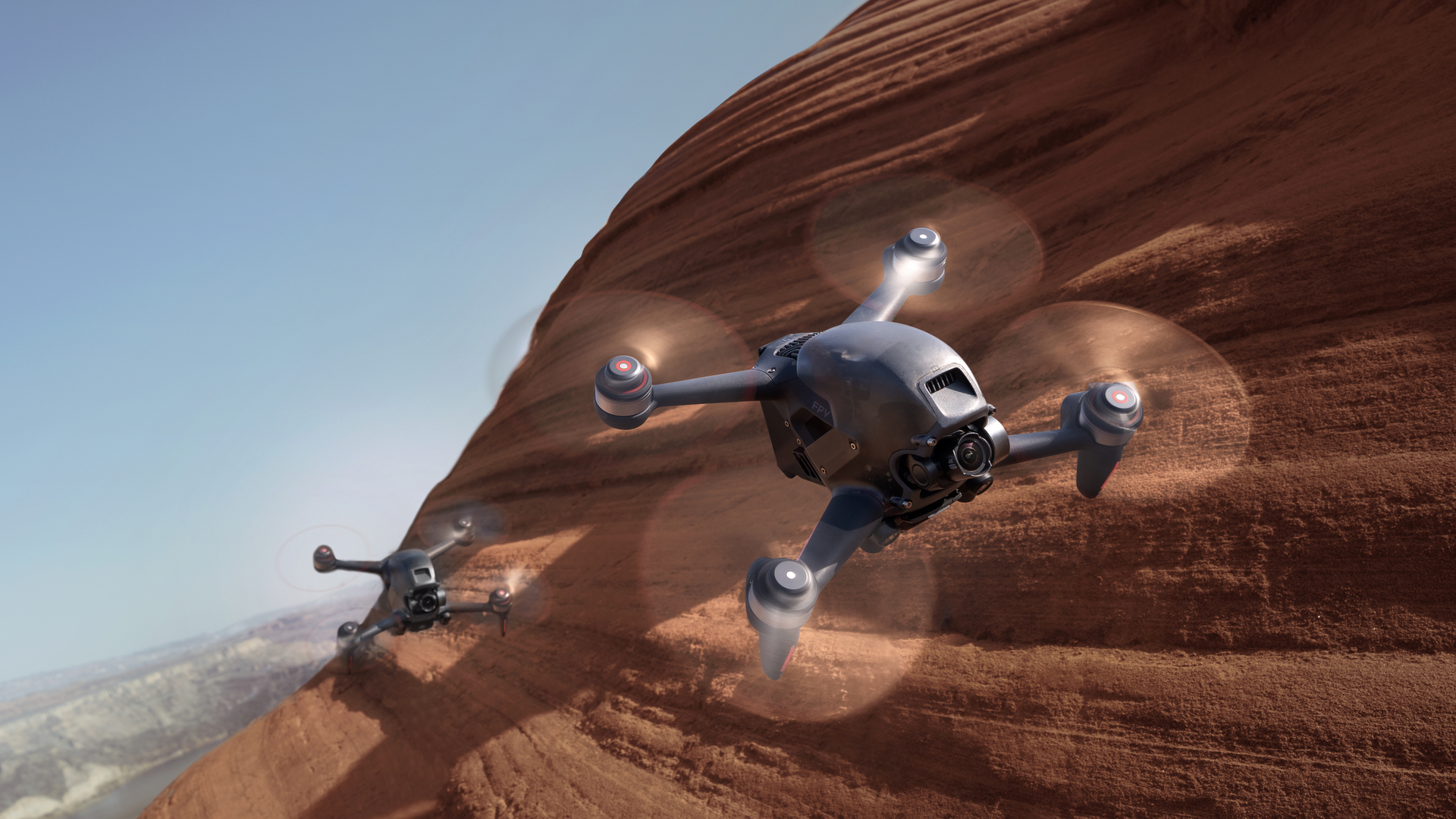
The DJI FPV drone is a sensational introduction to the thrills and spills of immersive first person view flight. Yes, it's not cheap and yes you will probably crash it, but we can think of no better way for financially-flush goggle-wearing wannabe pilots to indulge in the art of freeform flying and high-speed hijinks.
-
+
Immersive experience
-
+
Incredible speed
-
+
Steers like a dragonfly
-
+
Excellent safety features
-
+
Loads of fun
-
-
Not cheap
-
-
Expensive to repair
-
-
Requires balls of steel
Why you can trust T3

In this DJI FPV drone review, I'm going to be taking a closer look at the world's world's first tech-filled first-person view drone that's also suitable for beginners.
Most consumers are happy to just fly their drones around slowly while taking smooth cinematic video and high-resolution aerial stills, and there are plenty of options in T3's best drone guide that'll let them do exactly that. But there's also a growing throng of high-speed thrill seekers out there for whom that kind of relaxing pastime is simply not exciting enough. For them, there’s nothing more exhilarating and immersive than flying a specialised drone at up to 120mph through and around disused, obstacle-strewn industrial estates and abandoned buildings while viewing the world rush by in real time through a pair of stereoscopic goggles.
Well DJI’s gone totally off-piste here and created a fully-fledged, ready-to-fly 4K-quipped FPV racing drone, released in March 2021. It has also got enough clever safety features to make it suitable for newbies (this is included in T3's best drone for beginners guide). I got my hands on the DJI FPV Combo bundle and make no mistake, this drone is a stonker.
That's not without a caveat or two, through – namely the price (it's not going to be appearing in our best cheap drones list any time soon, let's put it that way) and the cost of repairs if – or rather when – you crash it. And if it's smooth and graceful cinematography you're after, you'd still be better off with the DJI Mavic 3 or DJI Mavic 2 Pro (head to our DJI Mavic 2 Pro vs DJI FPV face-off for a full comparison on the latter). But for video that's speedier than a dragonfly on steroids, the FPV is a top pick. Want to know more? Read on for our full DJI FPV drone review.
DJI FPV drone review: design
Where other FPV drones usually require being hand built from scratch and end up looking like Heath Robinson contraptions replete with an ugly profusion of wires and strap-on batteries, the new DJI FPV is a picture of elegant, streamlined perfection. In fact it looks like the love child of the high-end DJI Inspire and Ridley Scott’s alien. Imposing and a little bit scary, in other words.
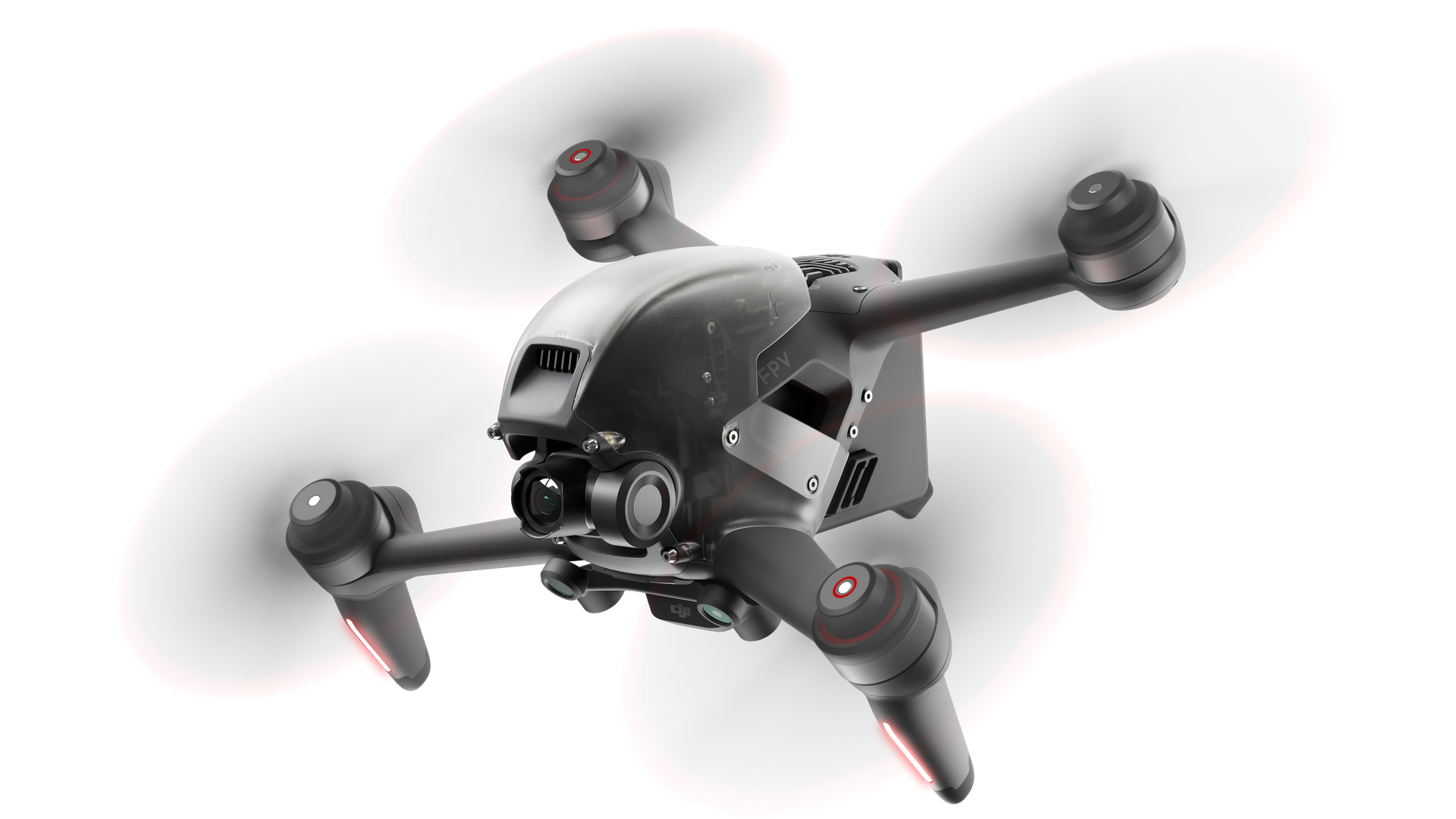
The new DJI FPV
Constructed mostly out of advanced plastics and designed to some degree to accept customer replaceable parts like landing gear, top shell and camera gimbal, the DJI FPV feels weighty in the hand (at 795g, it’s a lot heavier than any custom FPV racer) but undeniably solid. However, where DJI’s roster of cinematic drones feature folding prop arms for easy transportation, this one’s arms are fixed and that means you’ll need a bag big enough to fit its 255×312×127mm dimensions. You may also need to remove the propellers (easy to do) lest they’re deformed in transit.
Unlike other FPV drones on the market, the DJI FPV is equipped with a wide range of safety measures, including smart Return-to-Home (RTH), low battery warning, an auxiliary LED light and – crucially for a drone that is designed to be flown at speed around obstacles – forward and downward obstacle sensors that will bring the drone to a halt in an emergency.
DJI FPV Combo review: the goggles
There are numerous third-party goggles on the market but few hold a candle to these. Despite making you look like an extra from Star Wars, the DJI goggles are adjustable to fit any shape of head and pupillary distance of the eyes. They feel light on the head too because, rather ingeniously, the battery that powers them is placed in your pocket.
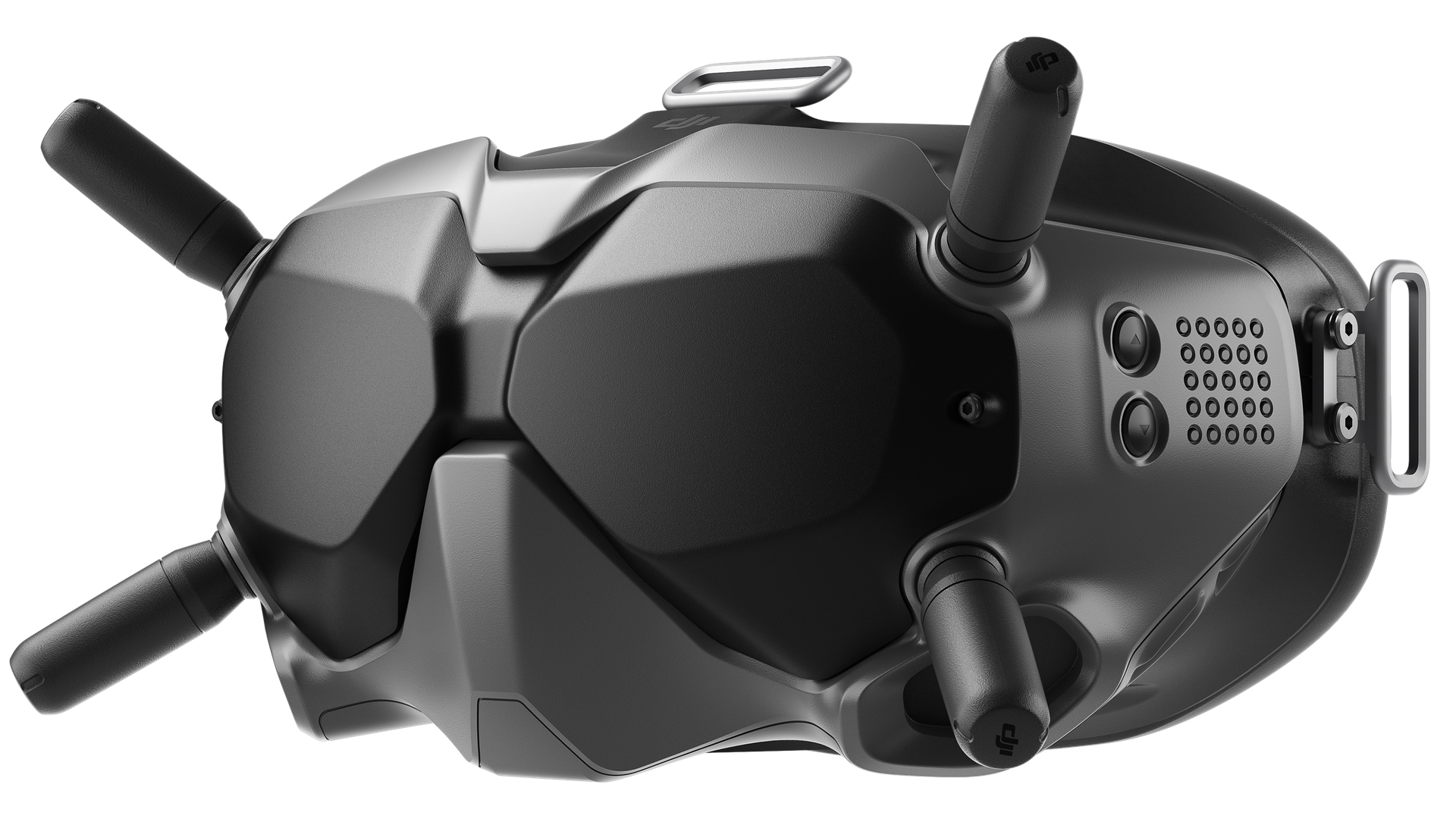
Make like a spaceman and strap this lot to your visage
The problem with so many FPV setups is that the quality of the visuals from the drone’s front-mounted camera is often poorly defined. That’s absolutely not the case here. In fact, the visuals these goggles produce are so exquisitely sharp you could easily watch a movie on them. The ultra wide 150˚ field of view is another major plus that gives the flyer full confidence when darting in and around tight, tricky spaces like forests and abandoned properties.
However, as is often the case when flying a drone in first person view, there’s a high chance the user will experience some nausea and possibly even a headache or two so be sure to take a rest after a few minutes of flying, or at least until you’re used to the experience.
- DJI Air 2S review: the ultimate camera drone
- After a toy option? Here are the best drones for kids
- How to buy the right drone for you
DJI FPV Combo review: hand controller
The DJI FPV ships with a beefy hand controller that will feel familiar to current DJI drone owners. However, there are a few different buttons on the rear that you’ll need to acquaint yourself with, namely the rear rocker switch that changes the flight modes from Normal to Sport and Manual. Aside from a video record and photo snap button, the controller also features a gimbal tilt wheel, even though most of the time you’ll fly the drone with the camera facing straight ahead.
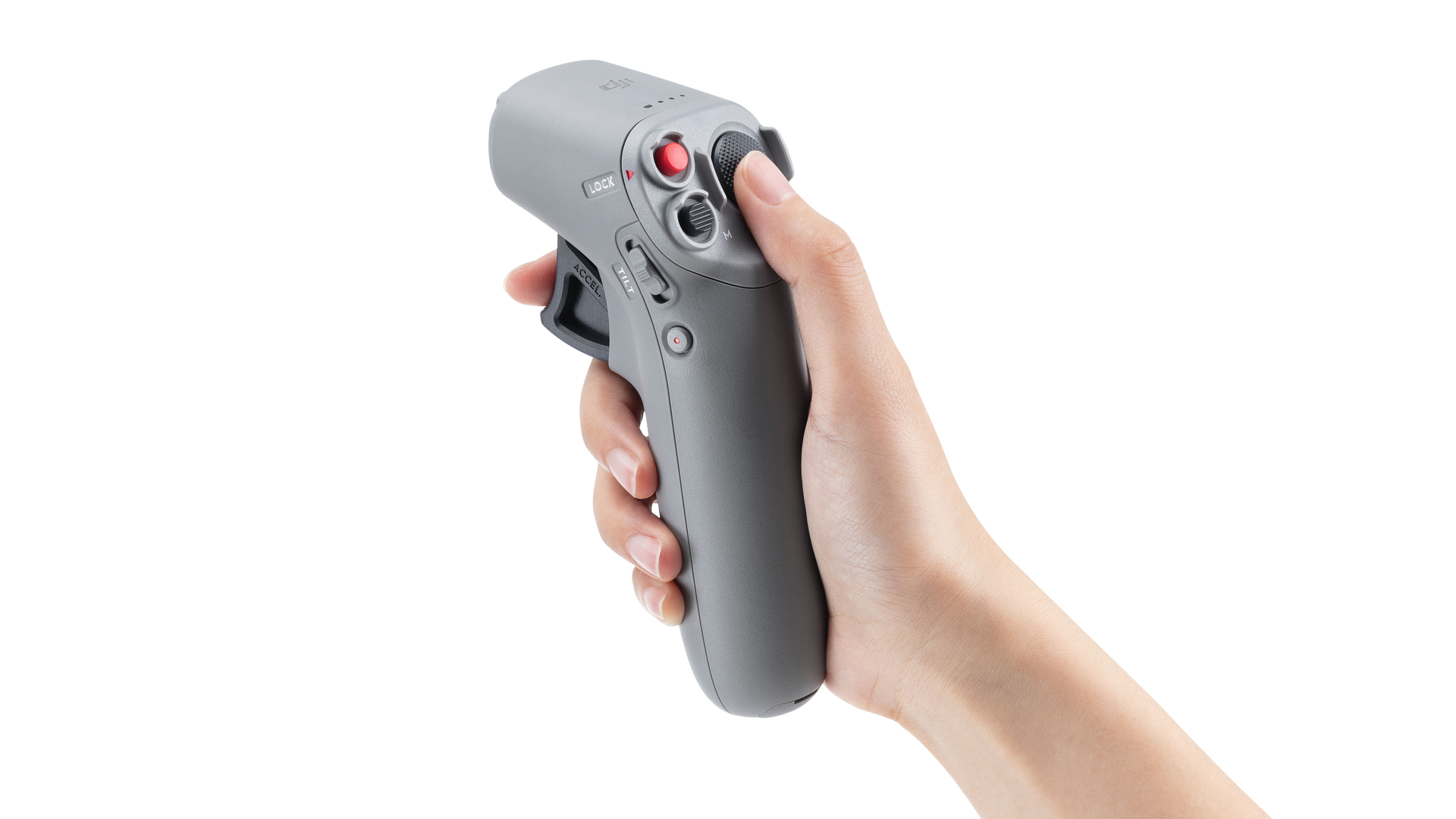
Once you've got some experience under the belt, consider investing in DJI's Motion Controller
For those wishing to try something completely different, DJI has also introduced an optional Motion Controller (£139 / US $199 / AUD $229) that lets you control the drone using hand motions alone. I found it surprisingly intuitive but also quite scary since you really need to be gentle on the movements. Put another way, I wouldn’t want to use it to fly at 85mph through a small concrete arch, at least not until I’ve had a few hours of practice in a wide open space. On the plus side, the Motion Controller is at least equipped with a big textured button that brings the drone to an instant halt and hover if things go awry.
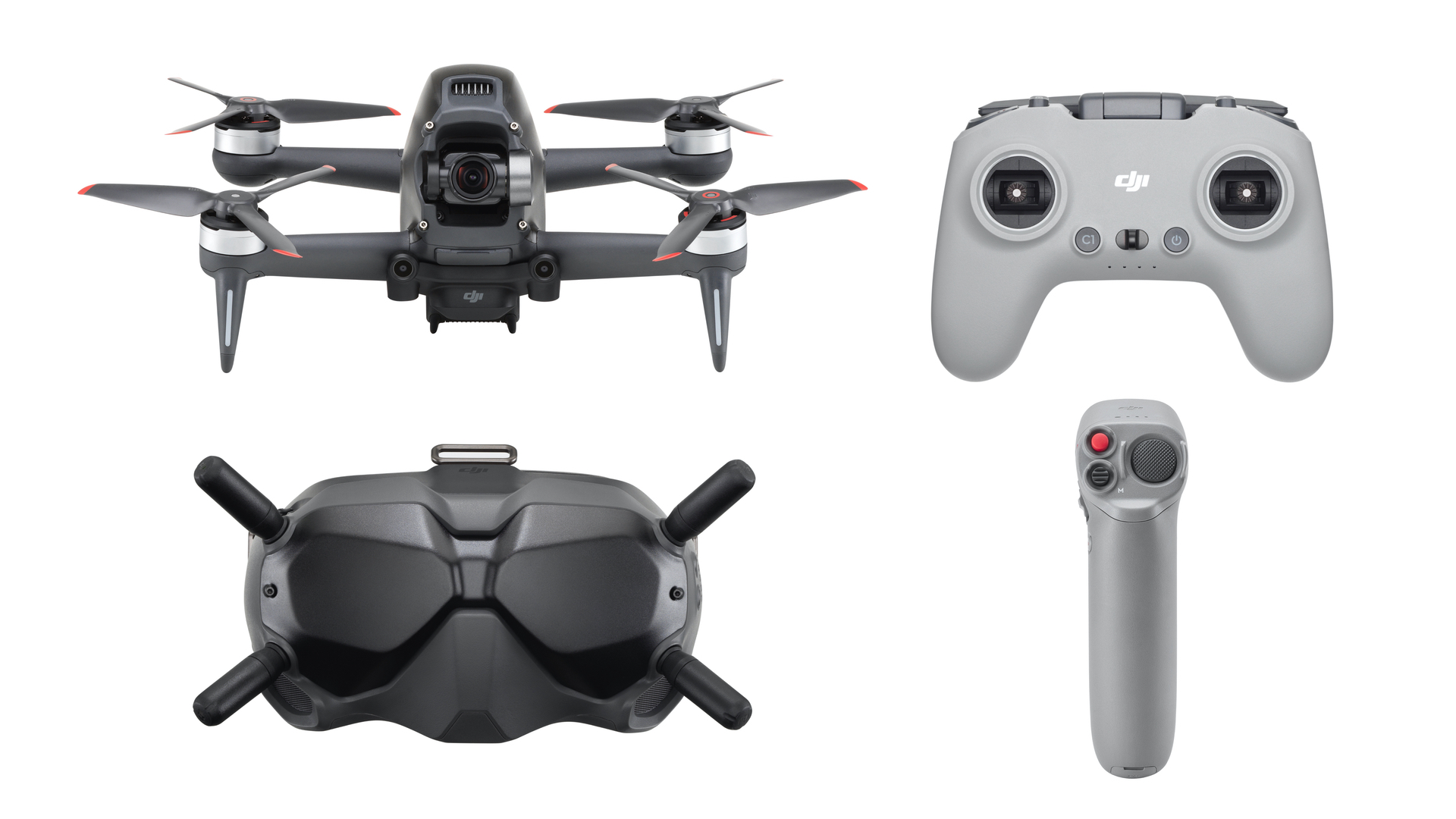
The DJI FPV Combo includes the drone, the goggles and a hand controller. The Motion Controller (bottom right) is an optional extra
DJI FPV drone review: pre-flight set up
Setting up the DJI FPV Combo is a more complex procedure than any other DJI consumer drone but thankfully way easier than any other FPV on the market. This is because the three main components – drone, goggles and controller – are designed to work in harmony. Consequently, when you switch everything on, it just works: an image comes on the screen and once the drone's built-in GPS system has detected enough satellites, it's ready to roll. If you’ve ever tried other FPV systems, you’ll really come to appreciate just how easy this package is to get in the air and fly almost immediately.
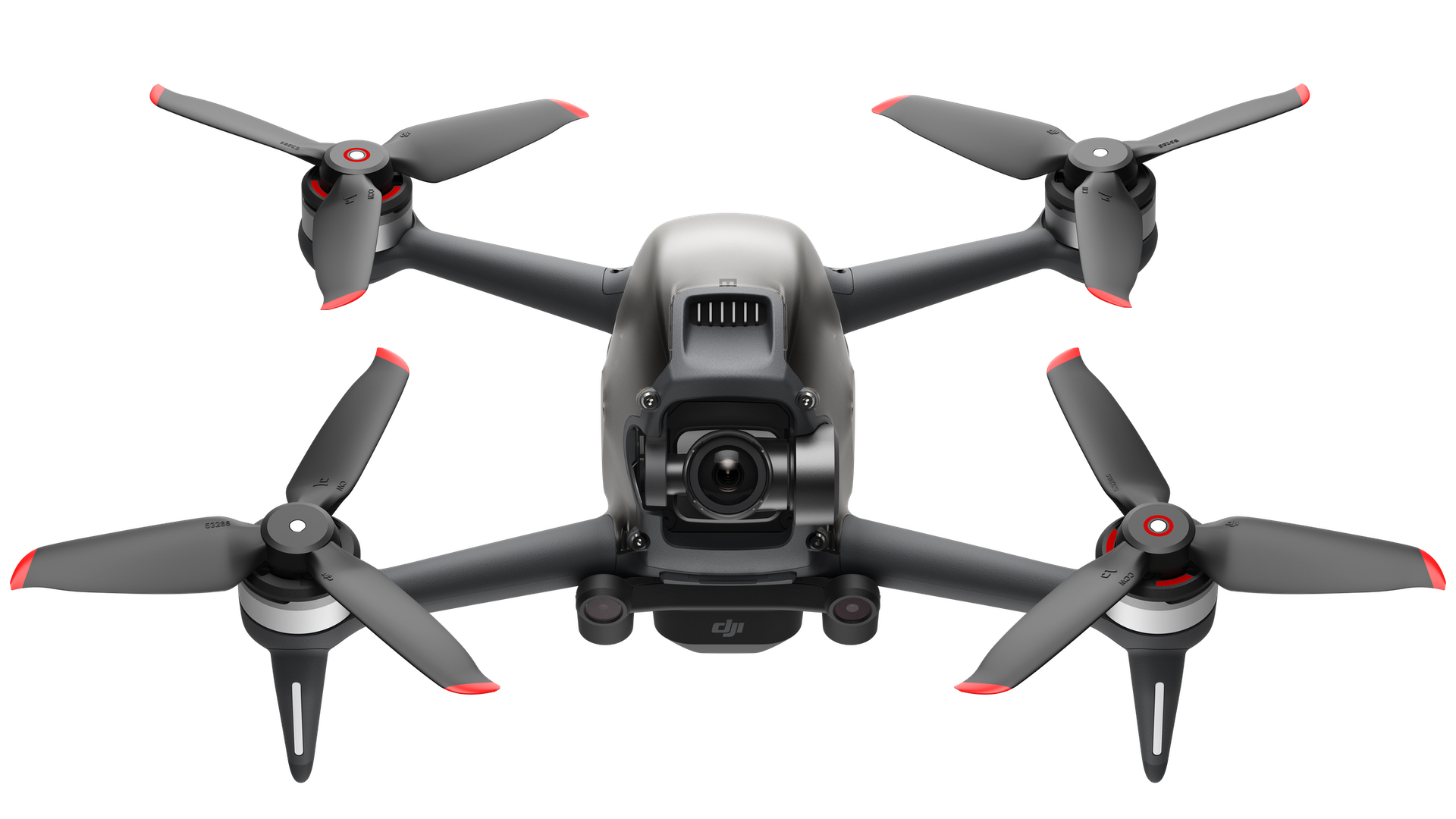
The DJI FPV is equipped with a highly competent 1/2.3" CMOS camera and two-axis gimbal for rocksteady image transfer
DJI FPV Combo review: camera performance
The DJI FPV's 1/2.3" CMOS camera is mounted to a two-axis gimbal that keeps images rock steady no matter how shaky the drone may be in flight. Like any camera drone, you can also record video up to 4K resolution and take aerial photographs. However, being of FPV origin, the gimbal’s lack of a horizontal axis means that when the drone banks to the left or right, the image follows suit. Banked visuals are part and parcel – indeed an essential element – of FPV flying so look elsewhere if you want to shoot horizontally level cinematic footage while banking.
The DJI FPV's camera may not be up the standards of the Mavic 2 Pro but it's easily as good as the best GoPro has to offer (the camera of choice for most ardent FPV flyers). As mentioned above, the imagery in the goggles is about as immersive as it is possible to get, short of strapping yourself to the nose of an aircraft.
DJI FPV drone review: flight performance
Where many custom-made FPV drones' visuals are prone to static disturbance if the craft is flown behind a tree or a little beyond transmission range, this one has no such problems. In fact, its ultra-stable OcuSync 3.0 transmission system remains crisp and sharp up to a distance of 10km (six miles), geographical and atmospheric conditions permitting.
The DJI FPV is equipped with three main flying modes. Normal is the ideal mode for beginners since everything is dialled down for a smooth flight experience with no hairy surprises. Top speed in this mode is around 33mph. Sport mode is the option to go for once you’ve got a few hours of flying under the belt. In this mode the drone is basically a lot faster (60mph) and much more agile and quicker to turn. Nevertheless, many of the drone’s built-in safety functions are still operational.
Once you've got a handle on these two modes, then start bracing yourself for the 'holy s**t' mode, better known as Manual. In this mode the drone behaves like a fully-fledged FPV racer, replete with ultra tight dragonfly turns and aerobatic flips and spins. The top speed in Manual mode is an eye-watering 86mph so this is clearly not the mode to select until you are totally familiar with all aspects of drone flight.
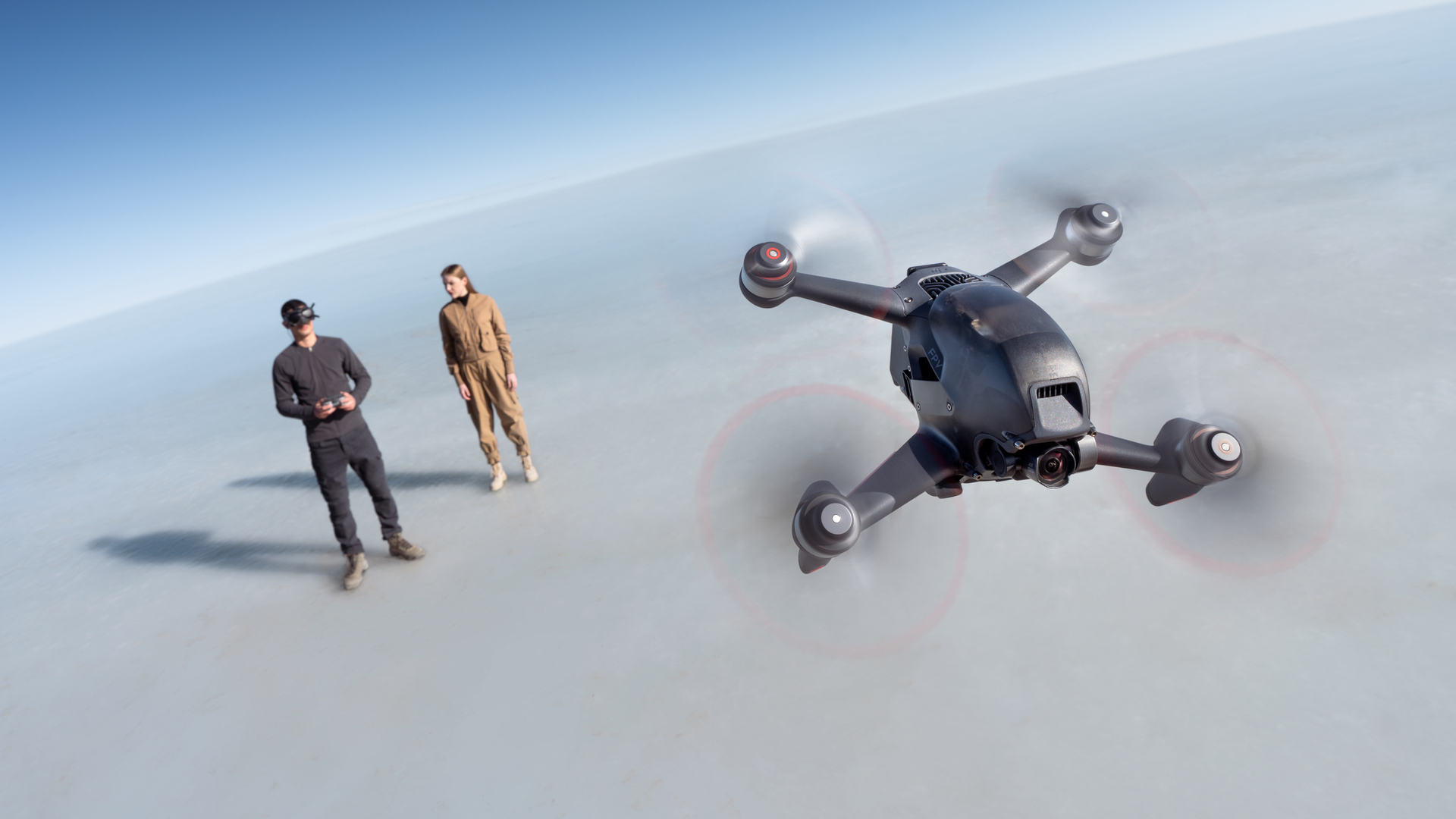
The DJI FPV even works on the outer ring of Saturn
DJI FPV done review: what's wrong with it?
No question, the DJI FPV is a cracking racing drone that excels in so many areas. However, FPV flying is often fraught with peril so if you think you may never have the nerve to fly at even modest speed between a cluster of trees, through a stone arch or the doorway of a disused industrial unit then think again before investing in a drone of this nature and perhaps opt for a DJI Mini or Mavic Air 2 instead.
You see, the main problem with this drone isn’t so much the price (£1,249), which is actually very reasonable for a package of this high calibre, it’s the cost and hassle of repair when you inevitably crash it. Yes, the drone has been designed with user repairs in mind – you can already purchase spare arm braces, landing gear and the whole gimbal and camera mount – but because it weighs so much more than a self-constructed version, chances are it'll come off worse in a head-on with a tree trunk or a concrete wall. Put another way, I've seen a lightweight pro-spec FPV drone fly straight into a brick wall at high speed and simply bounce away with just a broken propellor. I can’t see that happening with the DJI FPV. In fact I can only see tears.
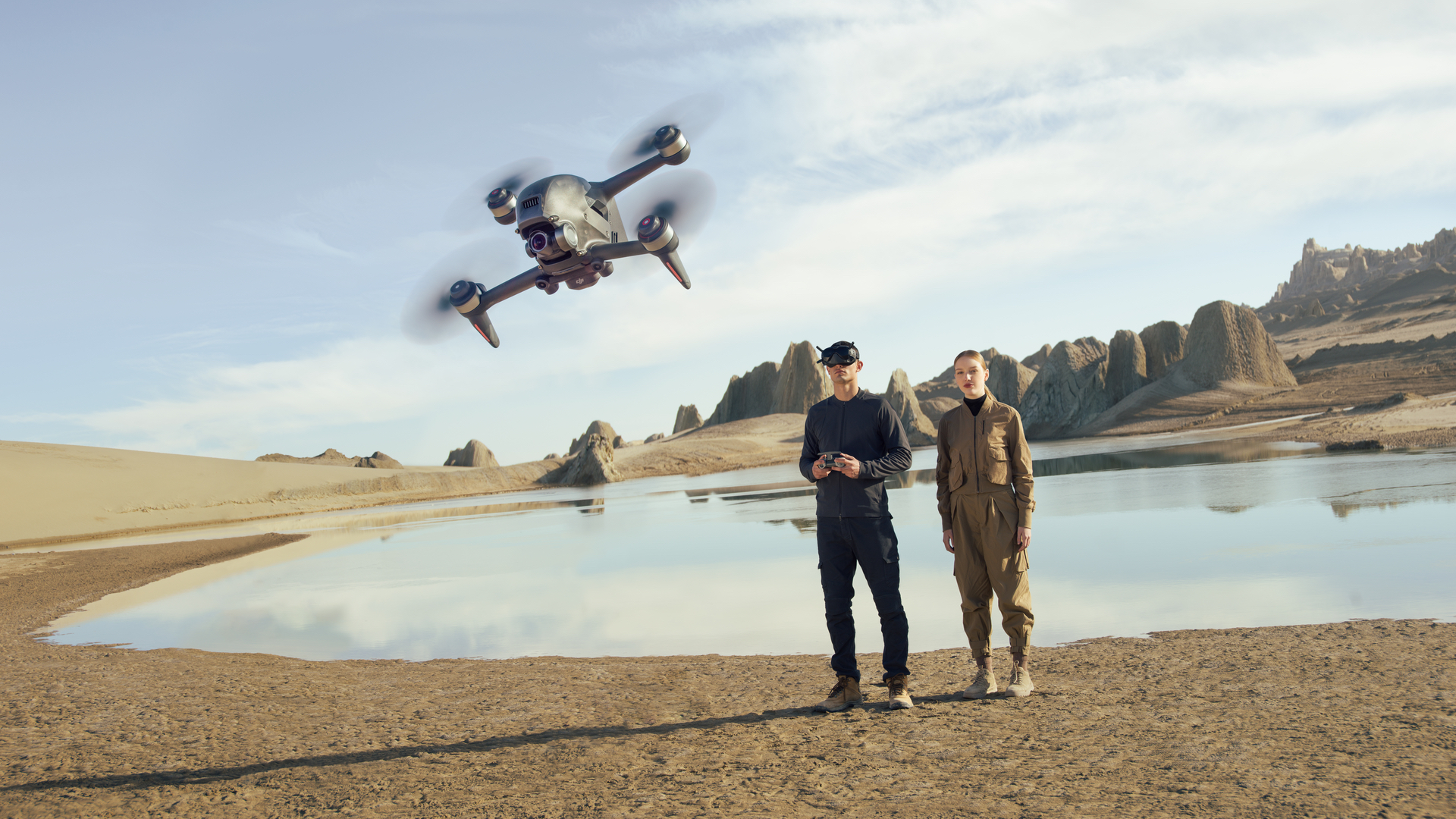
By law you will need a friend to act as an observer when flying wearing goggles
DJI FPV Combo review: who can fly it?
As of 31 December 2020, the Civil Aviation Authority (CAA) all pilots of camera drones weighing 250g or more (the DJI FPV, for instance) will need to purchase an Operator ID from the CAA and sit a short multiple-choice online examination. FPV flyers are also required to have an observer with them at all times and the spotter must be standing next to the pilot and not use any visual aids like binoculars. As an FPV flyer, you will also need to avoid flying closer than 50m to people, buildings and cars. Hence, if you wish to fly around a disused industrial unit or suchlike, your best best would be to join an FPV club.
You can find out more about CAA drone regulations or join a UK FPV club.
DJI FPV Combo review: verdict
Make no mistake, the DJI FPV is a highly accomplished introduction to the immersive thrills of FPV flying. It’s superbly designed and filled with a raft of tantalising flight assistant software that helps even the most drone illiterate flyer get an easy handle on the discipline of wearing goggles while wheeling around the sky at up to 86mph. But on the other hand, it’s also a highly specialised craft that requires balls of steel, a fat wallet and a stiff upper lip when things go pear shaped, which they inevitably will given the nature of FPV flying.
Sign up to the T3 newsletter for smarter living straight to your inbox
Get all the latest news, reviews, deals and buying guides on gorgeous tech, home and active products from the T3 experts
Derek (aka Delbert, Delvis, Delphinium, Delboy etc) specialises in home and outdoor wares, from coffee machines, white appliances and vacs to drones, garden gear and BBQs. He has been writing for more years than anyone can remember, starting at the legendary Time Out magazine – the original, London version – on a typewriter! He now writes for T3 between playing drums with his bandmates in Red Box (redboxmusic).
-
 Kenwood's latest matching toaster and kettle sets are a must-have for spring decor lovers
Kenwood's latest matching toaster and kettle sets are a must-have for spring decor loversStylish without the hefty price tag
By Lizzie Wilmot Published
-
 You might not know about it, but this Prime Video sequel is going to be enormous
You might not know about it, but this Prime Video sequel is going to be enormousCulpa Nuestra will be massive
By Max Freeman-Mills Published
-
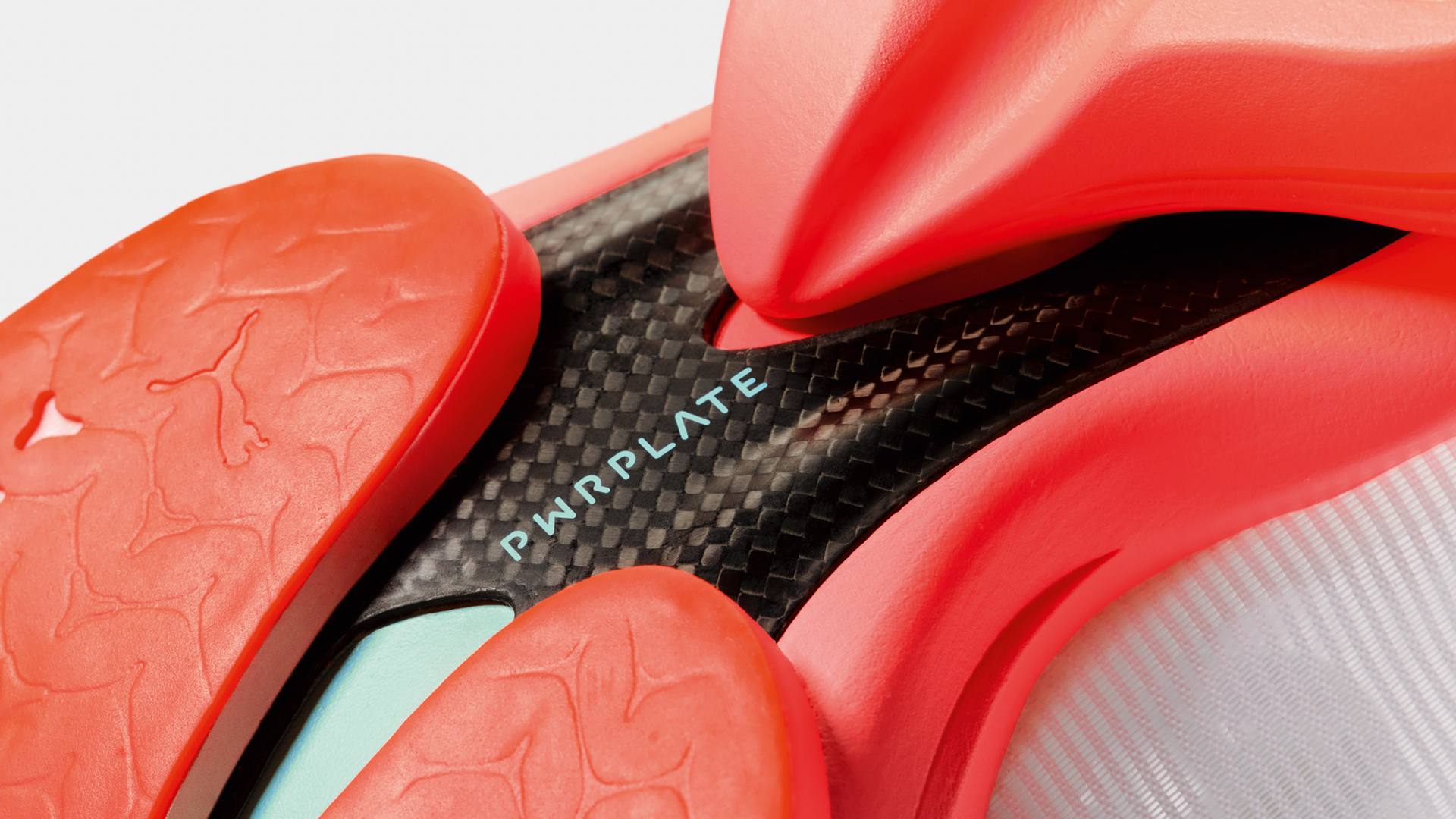 Puma’s radical new carbon racer claims to knock 4 minutes off your marathon PB
Puma’s radical new carbon racer claims to knock 4 minutes off your marathon PBThe Fast-R NITRO Elite 3 is the brand's lightest-ever super shoe, backed by SCIENCE
By Matt Kollat Published